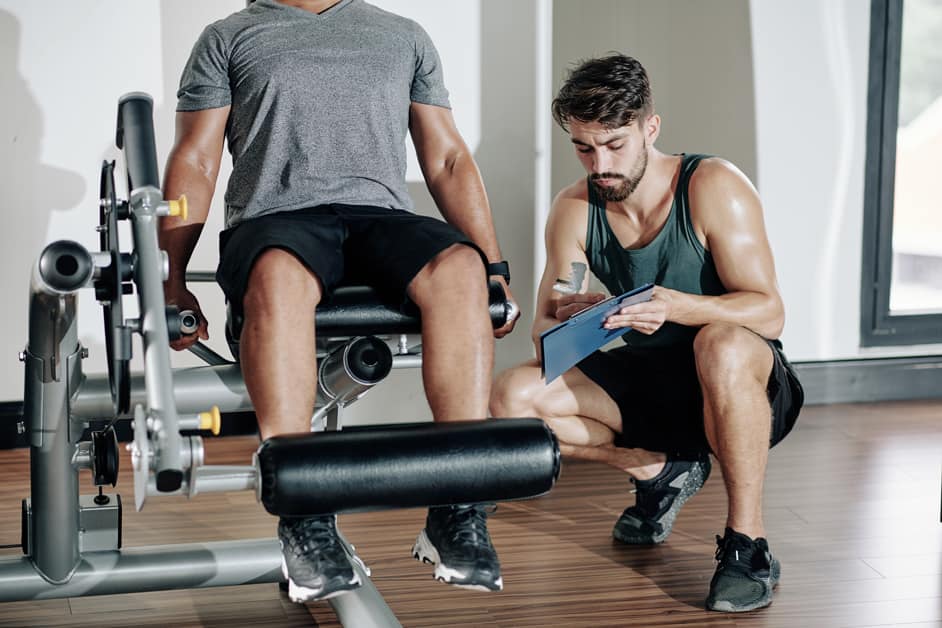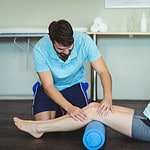Introduction
Leg extensions are a popular exercise for building strength and definition in the quads. However, they can cause knee pain. To do them safely, it’s essential to know how to perform them properly. This article will explain the purpose of this exercise and the key points of performance. Plus, tips for performing leg extensions safely. We’ll also cover the potential benefits and risks to help you decide if leg extensions fit your fitness goals.
What are Leg Extensions?
Leg extensions are a popular exercise for toning and strengthening the leg muscles, like the quadriceps. You can do this exercise with or without equipment. It’s about straightening the leg against resistance. People with knee pain can benefit from it, but they must consider their body’s limitations.
The primary muscles worked are the quadriceps. These are four big muscles in the front of your thigh. They extend and stabilize your knees. Other muscles, like calves and hamstrings, may be used too. There are many benefits: better strength, better stability, increased range of motion and improved posture.
People with chronic or acute knee pain might do leg extensions as part of physical therapy. But you must be aware of any sensations or pain to avoid further damage. Use slow, controlled movements. Don’t go beyond your comfort level. Avoid overloading joints or using too much resistance. Talk to a qualified professional before attempting it on your own.
Benefits of Leg Extensions
Leg extensions are a well-known exercise. They can benefit the muscles in your legs and the stability of your knees. But, you must be aware of the potential risks if you experience knee pain.
A great advantage of leg extensions is that they can strengthen your hamstrings. This increases the size of your legs, while also reducing strain on your knees. They are also a great way to enhance strength in your core muscles and joint stability in your hips and pelvis.
If you are looking for a workout that is tough but low-impact, leg extensions may be just what you need. Lighter weights let people of all levels progress safely. They can also help with balance and coordination, so you can carry out daily tasks better.
To get the most out of leg extensions, it is essential to follow the correct technique and form. This is especially true for athletes with knee pain or injury issues. Safety should be the top priority when doing any lower body exercise.
Risks of Leg Extensions
Leg extensions target your quads. They can help build muscle, but be careful! Straining your knees is a risk. Before trying them, it’s important to know the risks. Let’s explore what could go wrong with leg extensions:
- Straining your knees.
- Injury to your hip flexors.
- Stress on your lower back.
- Tightening of your hamstring muscles.
Knee Pain
Leg extensions can cause knee pain and discomfort. They don’t cause medical issues, but they can make existing issues like arthritis, bursitis, or tendinitis worse. Knee instability can be a problem too. It’s caused by using too much weight or doing too many reps. If you don’t use the right form, it can put too much stress on your body, causing more pain.
If you have knee pain, high-repetition exercises might not be the best choice. Speak to a physical therapist or doctor before doing them. Doing lighter reps with less impact is better for protecting your joints.
Muscle Imbalances
Leg extensions target the front thigh muscles, specifically the quadriceps. It’s a popular exercise used to build size and strength. But it can pose risks for those with knee pain or instability because of muscle imbalances.
When doing leg extensions, it’s important to use proper form and technique. This means avoiding too much weight, which can cause the knee to move in ways other than linear. Too much weight on an injured knee joint or muscle imbalance may make the injury worse.
Athletes with patellar tendinopathy or chronic patellofemoral syndrome should be careful with leg extensions because of the increased risk of overloading the affected structures when intensity or range of motion is high.
To reduce risks, focus on proper form and adjust tension slowly. Also, warm up the joints and tissues in the movement area before starting so you can perform optimally.
Alternatives to Leg Extensions
Leg extensions are a nice workout to beef up the quads. But, if you have knee pain, it can make it worse. Good news! There are different exercises to get strong quads without hurting your knees. Let’s check ’em out!
Glute Bridges
The glute bridge is a bodyweight exercise for building strength in your glutes, quads, hamstrings and lower back. Lie on the floor with bent knees and feet flat. Squeeze your glutes, lift your hips to form a line from shoulders to knees. Hold this for 2-3 seconds, then lower. Do 10-12 reps before feeling tired or fatigued.
To increase difficulty, go slower and control each repetition. Add equipment like an exercise ball or mini-band for extra muscle activation and stability. Place a mini-band above both knees for external resistance. This makes it harder to lift and lower your hips, while giving joints support.
Step-Ups
Step-Ups are a great way to target your quadriceps. To do them, you’ll need a step or plyo box and some weights.
- Stand tall with feet hip-width apart. Contract your core and step onto the box one foot at a time. Pause when both feet are on the surface.
- Drive through the heel of your front foot. Press up and off the box until both feet are back on the ground. Step back down one foot at a time. Repeat 8-12 reps before switching legs.
Adding weight increases the challenge. But don’t add too much. More weight doesn’t mean more progress.
Lunges
Lunges are a great choice to replace leg extensions. They offer more balance and stability, plus work the lower body including hamstrings, quadriceps, glutes, calf muscles, core, and stabilizers.
To do a lunge, stand with feet hip-width apart and hands on hips or out to sides. Step one foot forward. Bend both knees 90 degrees, so the back knee nearly touches the ground. Keep your torso upright and press into the heel to get back up. Engage your core as you stand. Do 10 reps for 3 sets each leg. For variation, walking lunges will work larger muscle groups like quads and hamstrings all at once.
Have a break of 30-60 seconds in between sets before changing legs or starting another exercise.
Conclusion
In the end, leg extensions may help to strengthen muscles around the knee joint, leading to less knee pain. But, be careful with this exercise; it could lead to further injury. If you have knee pain, talk to a doctor first before trying it. Additionally, adjust the weight and range of motion to lessen discomfort.
Ultimately, each person must decide if leg extensions fit their routine and take the necessary precautions:
- Talk to a doctor first before trying the exercise.
- Adjust the weight and range of motion to lessen discomfort.
Frequently Asked Questions
Q1: Is it safe to do leg extensions if I have knee pain?
A1: It is not recommended to do leg extensions if you have knee pain, as it may cause further injury or aggravate your existing condition. It is best to seek professional advice from a physiotherapist or doctor before performing any exercises that involve the knee.
Q2: What exercises can I do that won’t aggravate my knee pain?
A2: Low-impact exercises such as swimming, stationary cycling, elliptical, yoga and Pilates are all safe and beneficial for those with knee pain. These activities will help to strengthen the muscles around the knee joint whilst protecting the joint itself.
Q3: What other steps can I take to help with my knee pain?
A3: In addition to low-impact exercises, other steps you can take to help with knee pain include icing the joint, using a foam roller, taking anti-inflammatory medications and using a knee brace. Seeking professional advice from a physiotherapist or doctor is also recommended.





